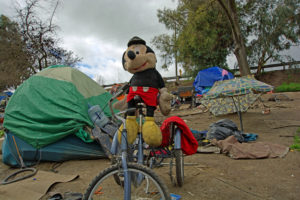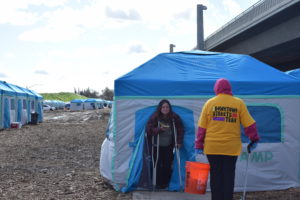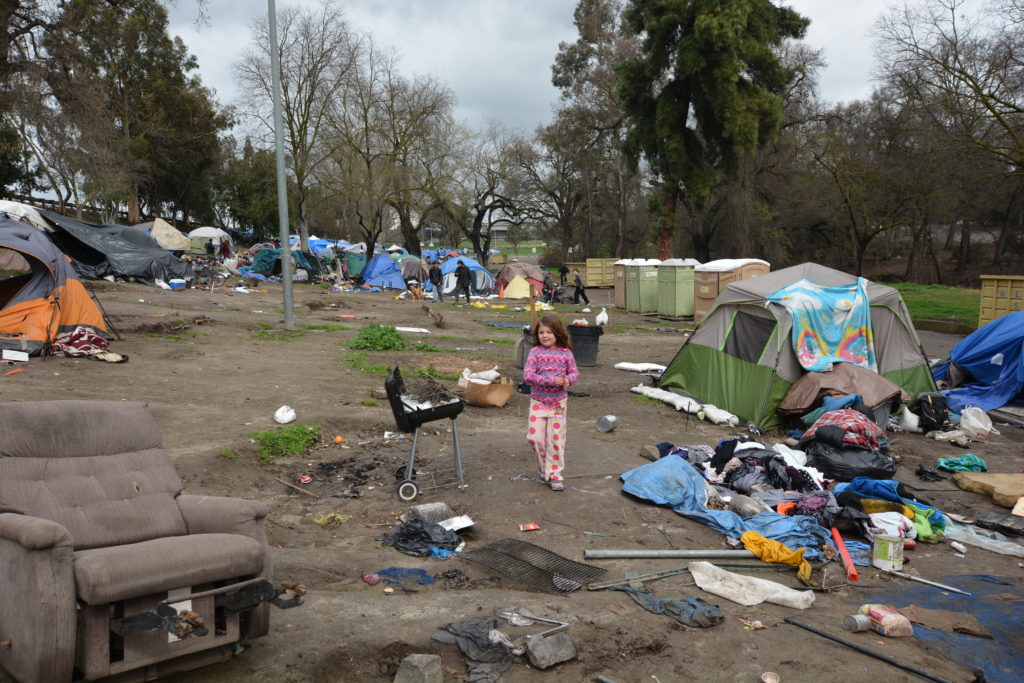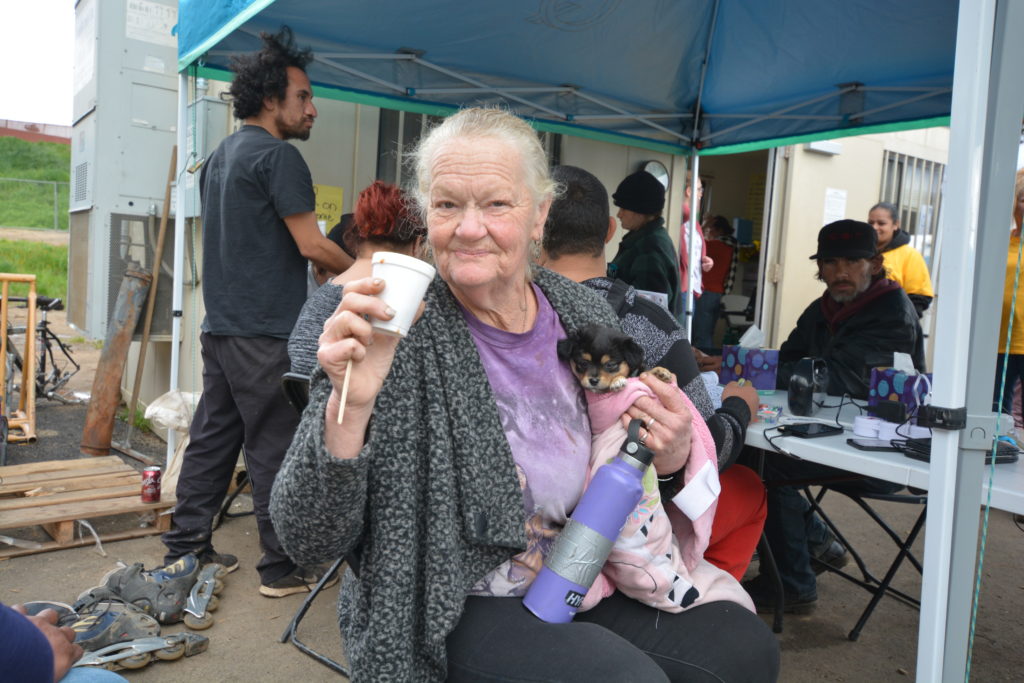
The last days of Beard Brook Village were like the aftermath of a natural disaster— people pawing through the rubble of discarded clothing, bicycle parts and cooking utensils, a stream of humanity pushing shopping carts, baby strollers, and wheel chairs to and fro, and loose dogs everywhere.
The debris-strewn chaos of Beard Brook was in stark contrast to the city’s new encampment, tentatively called Gateway Village, where uniform rows of identical tents spread out on a bluff overlooking the Tuolumne River only a few hundred yards from Beard Brook Park.
But up close, even the military order of the new encampment showed signs of yielding to the persistent entropy of homelessness. Despite applications of wood chips meant to keep the place dry, heavy rains have left pools and mud most everywhere. Seemingly oblivious to constant warnings, many campers have been stacking random belongings outside their tents in violation of one of the new rules for residents.
Nonetheless, in countless ways, the new site has offered many people a vast improvement over Beard Brook Village. Most villagers now have considerably larger tents—the new ones are 10×10—and better security than they did at Beard Brook. There are more coordinated service efforts, and more staff to assist people with special needs.
While many campers were spooked when a chain link fence went up around the new site, the fence has proved helpful in stemming the constant flow of outsiders, opportunists and outlaws that afflicted the Beard Brook site.
Especially for the elderly and infirm, just being on level ground is a vast improvement over the steep slope at Beard Brook. Picnic tables in front of a small trailer at the north end of the camp offer a gathering place where people can share morning coffee and pastries, and the trailer is staffed by outreach workers and volunteers ready to help almost every day.
While city and county authorities have done an outstanding job directing the transition from Beard Brook to Gateway, problems loom. Local spokespeople keep insisting the encampment is temporary and will be taken down by June or August at the latest.
But thus far, the only alternative to camping is a plan to add 180 beds to the nearby Berberian Shelter, run by the Salvation Army. There’s also a proposal to purchase another Salvation Army facility on 7th and I streets in downtown Modesto and use it as transitional lodging for families.
At slightly over 200 more beds, the proposed alternatives to camping will fall far short of accommodating well over 400 people, the peak population at Beard Brook. And that’s not even counting the hundreds who remain downtown, and in streets and parks throughout the city.
Many people have forgotten that Beard Brook Village came to be as the result of a ruling by the Ninth Circuit Court that homeless people could not be prosecuted for sleeping outside if no alternatives were available. Local authorities made a wise decision in allowing people to camp, but have been stymied by the costs and obstacles in the way of more permanent solutions.
There’s also a persistent myth that homelessness will be solved when people get back on their feet and become self-sufficient. Anyone who’s had a close-up view of homelessness realizes the problem does not stem from any single cause, and most especially not from a failure to work.
First and foremost, a very large percentage of homeless people—some say as many as a third—are seriously mentally ill. There’s also a growing population of elderly homeless people whose Social Security incomes haven’t kept pace with housing costs, and another segment whose disability incomes have followed the same trajectory. Hardly any members of these groups will ever work enough to become self-sufficient.
Conventional wisdom attributes homelessness to drug use—the needles!!!—but drug use is often a consequence of homelessness rather than a cause. And until we start treating it as a health problem rather than a character failing, we’ll make no progress on reducing its effects.
The one thing we do know with certainty is that conventional treatments for addiction work with only a small percentage of users, so that’s another segment of the homeless population that isn’t going to be up and on its feet anytime soon.

The other stark reality is that in the new economy, work doesn’t necessarily lead to housing. For many in the San Joaquin Valley, $12 an hour is above average pay; no one can find satisfactory living conditions on that sum, especially if they need reliable transportation.
To their great credit, local authorities have managed the manifold problems of sheltering homeless people very well so far. Smart city cops and closely involved county staff people have handled a devilishly difficult situation as humanely and efficiently as anyone could expect, but no one has yet offered a convincing plan for what comes next.
Given the magnitude of the problem, no lasting solutions to homelessness will happen without large infusions of federal and state money, no matter how much we wish otherwise. Meanwhile, many people closest to the problem are agreeing that camping is a better option than a return to the streets.
Absent realistic alternatives, local authorities would be wise to listen. Beard Brook Village may be past history, but for the people who camped there and the many others like them, there’s still no end game.



Thank you for providing a very accurate description of the situation at hand. Despite not having any permanent solutions, I felt that this was very well-written & balanced when discussing causes & those impacted.
Well it they the city’s would get off they’re ass and help those who are HOUSELESS and give them a place to call home ,the city’s has a lot of vacant building’s and houses that are sitting with no one in them .that would solve the problem .
“ Give them “ Really? I want to see Someone or Some Agency Give Free Housing? You’re living in La, La, Land if you think that’s EVER going to Happen!
Why does the city owe anyone. They have done more than most. After seeing the BBV situation and the aftermath, I for one am tired of the bellyaching. The city, the volunteers who have worked endlessly, donation warriors who have gives beyond all imagination…to what end. A few success stories, wonderful. But mostly things are the same, people are the same. I will tell you what I tell my children and grandchildren…CHOICES CHOICES CHOICES. Every action has a consequence. Sometimes you can help to much. Eveeyone needs to be irresponsible for their choices.
First I want to say this is fantastically written and I thank you (Eric) for your balanced representation.Next I want to restate as I have for year’s,we can have a million resources offering help but if their are no houses to rent and regulations to build them are too difficult for builder’s nothing you do is going to be effective,so in short your waisting money.As far as Vacant building to house the homeless,The City and County owns a lot and it only takes a public record’s request to find out how many.Sadly too many people have idealistic solutions that only pacify our community,this is done to create an illusion that they are really helping,but as anyone with eye’s and a brain can see,Homelessness is getting worse not better.My solution would be to fast track building codes,amend land use laws,create incentives for builder’s,work on fare and balanced rental law’s,start building new affordable housing FAST and audit all program’s that are intended to help for their effectiveness and spending,Then and only then might we make a true dent in creating something we as a community we can be proud of.
Bob, love your solution ideas, it will take some real changes to the building process as you suggest. I just read this and want to share as it addresses the issue from a different perspective, The Green New Deal: https://www.jacobinmag.com/2019/02/green-new-deal-housing-ocasio-cortez-climate
Also, about a year ago I investigated the county and city of Modesto owned property and what is vacant is actually very little. The biggest issue, no matter who owns the property, is the NIMBY issue as witnessed by two failed attempts to site a Homeless Low Barrier Shelter.
Thank you Bob. I agree with you and Frank that we need to look harder at obstacles to providing affordable housing. Regulations should provide benefits, not liabilities.
I’m a down town street team member and live at gateway village I’m on disability a year clean and sober honestly 70% of the population here is in active addiction .If there not willing to address there addiction your enabling them u got to pull weeds . Feed weeds expecting flowers?
Another well written, insightful article Eric (and interesting follow-up comments.) I remember there being a homeless/house-less population in Newman when I grew up in the 50’s 60’s…but they were “ours” to care for when we had spare food, clothing or a chore “for hire” (if they were able.) Some were WWII or Korean vets with PTSD, some were alcoholics (also often an after effect of the war)…. and there was likely even some drug use back then, but the safety net of a County Mental Health facility and County hospital in Modesto kept their numbers low and their health better than one would expect in those conditions. In addition, one of the local lumber companies in town, allowed folks to construct a make-shift Shanty Town on a corner of that property, and as children, we knew several of those sad and lonely people by name and befriended them (as curious kids with no preformed judgments are wont to do.) But with different times, more people unable to work or afford housing (and simply more people in general) as well as both the County Mental and Public hospitals closed, there is no longer a safety net, much less even a system in place to handle the burgeoning problem we are faced with today.. Unfortunately, these poor souls are now dependent, as Blanche Dubois would say, “on the kindness of strangers.” Sadly, like today’s public funded tent housing, that kindness also seems to be in short supply and I see the whole situation as both a heartbreaking and difficult to solve situation with respect to any long term solution given the current environment not only in Modesto, but nationwide.
The country as a whole has very simply failed the “least among us” including many who served their nation in battle (and may still be carrying the scars of war) in their time of greatest need, be it just a roof over their heads, or the need for hospitalized treatment for the diseases that often go hand in hand with chronic health issues or addiction.
Thank you Babette. I agree that simple arithmetic explains many of our problems with homelessness. If a percentage of the population is seriously mentally ill, and the population grows, the number of mentally ill people grows, And if we stop caring for the mentally ill, we find more mentally ill people are homeless. And so it goes.
Those of us who’ve had problems and are of a certain age will remember “flophouses,” usually hotels where rooms could be had cheap by the week. The Covell was one in downtown Modesto. Today, people on Social Security or disability can’t find a flophouse; the worst lodging at a roach motel is $60 a night.
Those who would blame homelessness on failings of moral character refuse to look at the numbers. And I agree also that the “winos” and others in our midst used to have refuge, not just in the form of cheap rooms but in regard to sympathetic government and programs. We’ve become much more mean-spirited since then.